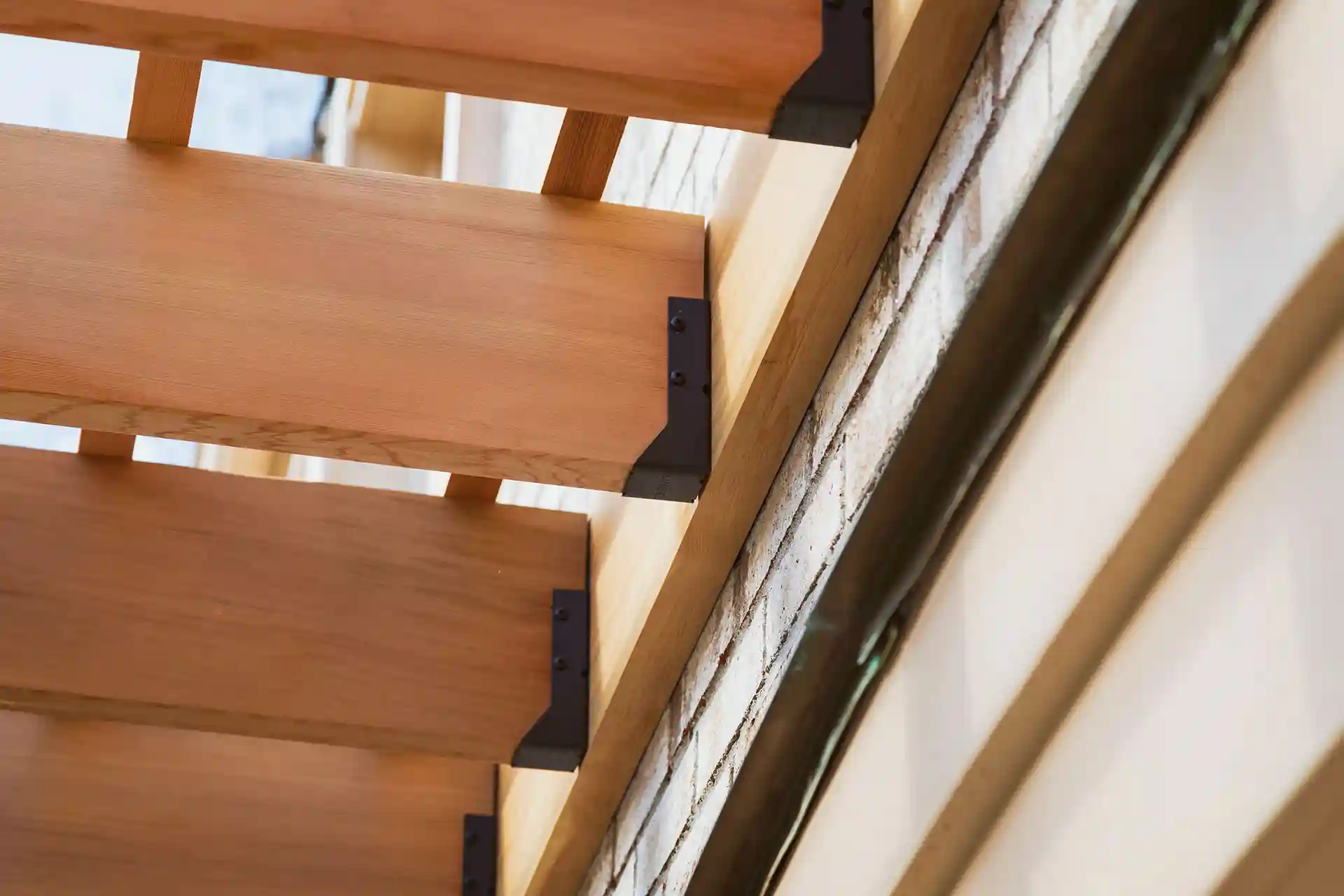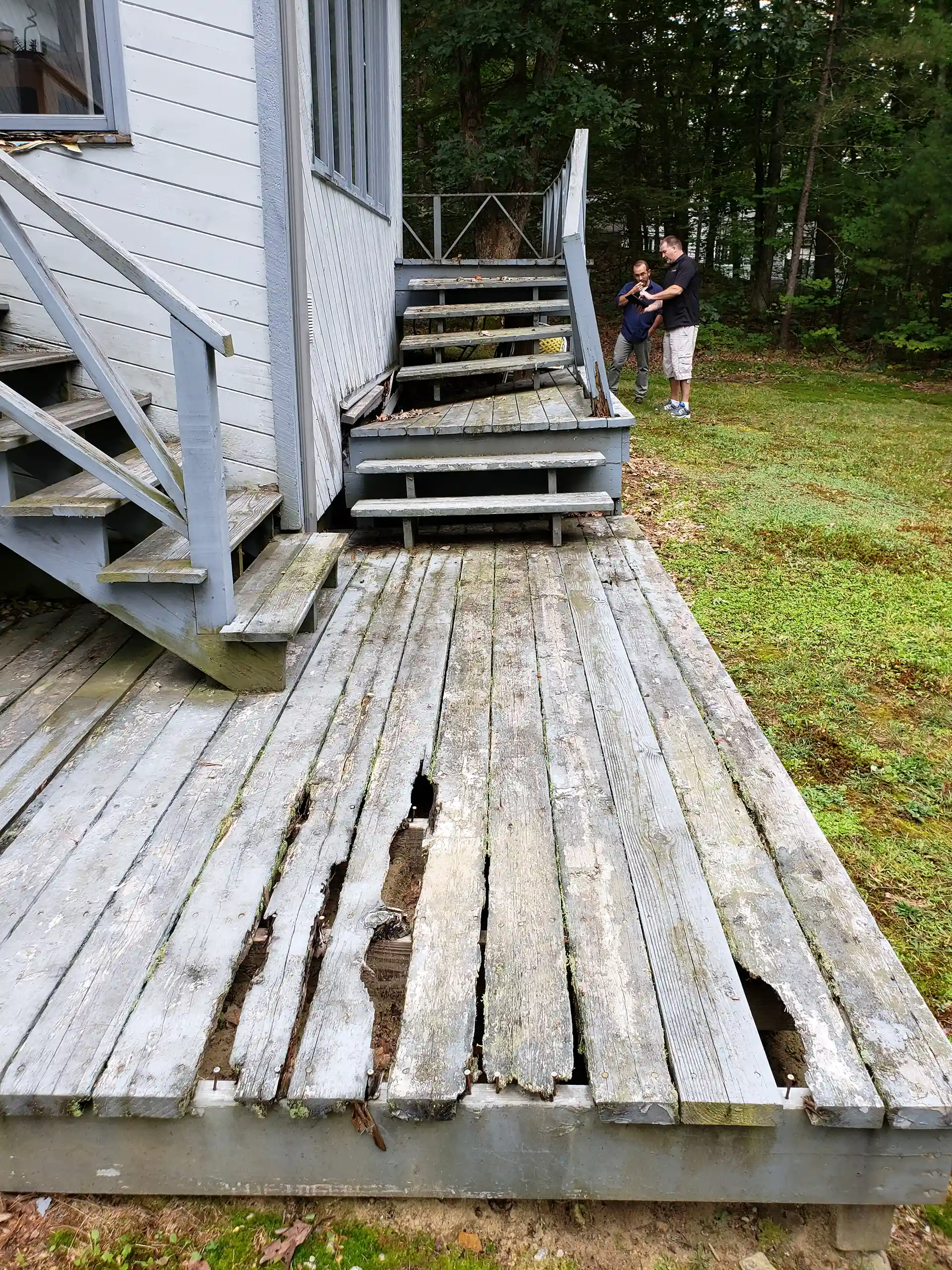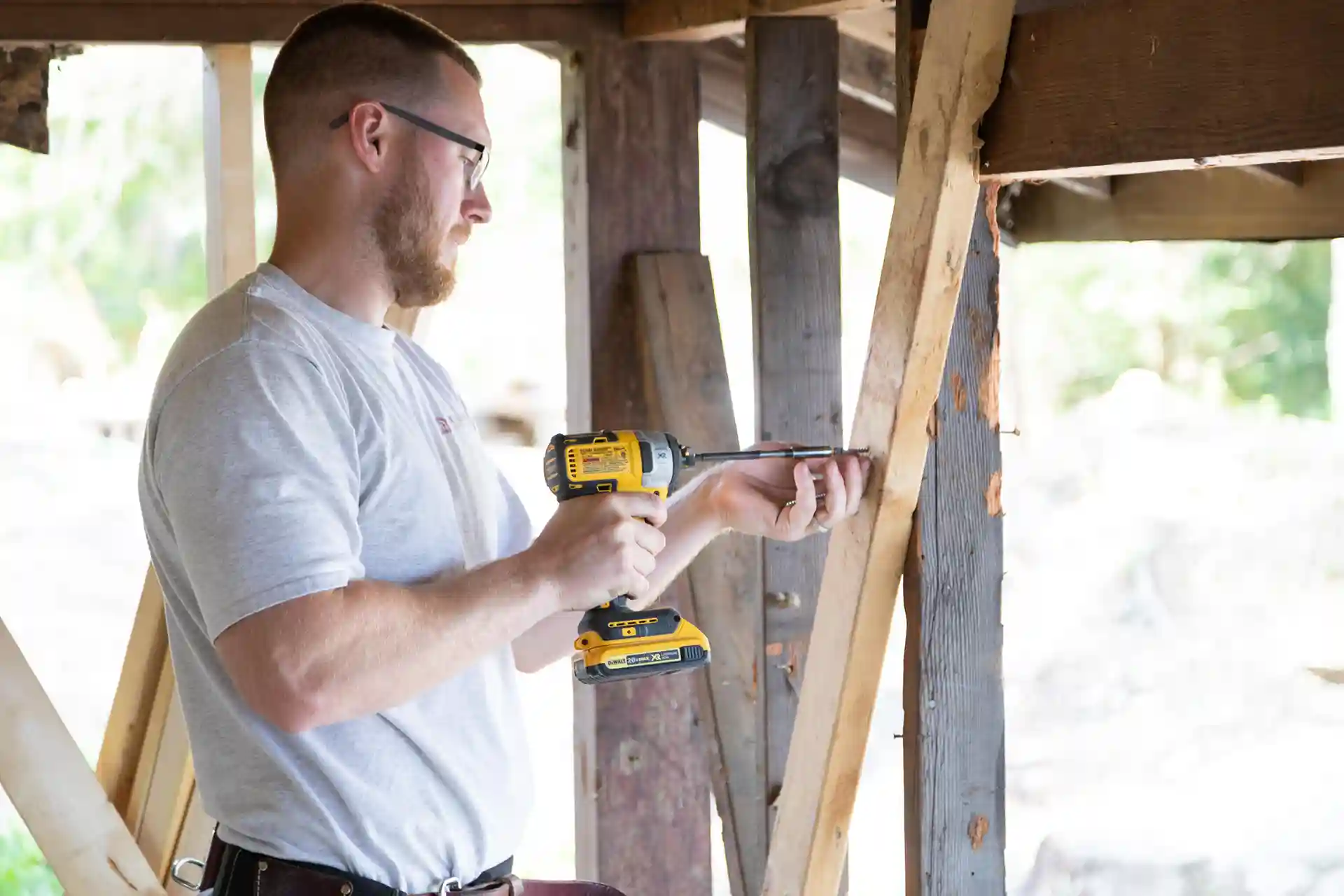
Your deck is a valuable extension of your home, providing space for relaxation, entertainment, and outdoor enjoyment. However, the weather in Merrimack County presents unique challenges. Snow, ice, freeze-thaw cycles, and seasonal moisture can cause hidden damage that compromises your deck’s safety and lifespan.
Regular deck inspections are essential to keeping your deck structurally sound and safe for your family. This guide will explain why inspections are crucial, how often to inspect, the signs of deck problems, detailed inspection areas, and how to choose the right professional.
Why You Should Schedule a Deck Inspection
Decks endure constant exposure to harsh elements and daily wear. Without proper maintenance, structural components can weaken, leading to:
- Freeze-thaw cycles that expand and contract wood and fasteners, loosening connections
- Heavy snow loads are stressing footings and framing.
- Water intrusion leading to rot, mold, and mildew.
- UV radiation is fading and weakening decking surfaces.
A comprehensive deck safety inspection checks your entire deck structure—from the substructure footings to the guardrails—to catch issues before they worsen. Early detection can prevent accidents and extend the life of your deck, saving you thousands in repairs.
Deck Safety Awareness: Protect Your Outdoor Space
Regular deck safety inspections prevent accidents and costly repairs. The North American Deck and Railing Association (NADRA) offers a 10-Point Deck Safety Checklist, guiding homeowners through key inspection areas like structural wood components, fasteners, guardrails, and hazards around the deck.
Following these recommendations and scheduling professional inspections helps keep your deck safe and enjoyable year-round.
What Happens If a Deck Fails Inspection?
When a deck fails inspection, it means one or more critical safety or code compliance issues were found, such as:
- Footings and Posts: Cracks, rot, or frost heave destabilize the foundation.
- Joists and Framing: Warping, rot, or splitting weaken the support structure.
- Guardrails and Railings: Loose, damaged, or undersized components increase fall risk.
- Deck Surface Issues: Rotting or broken boards that can cause trips or collapses.
- Deck Stairs: Broken treads, loose handrails, or unsafe construction.
Failed decks must be repaired or rebuilt to meet safety standards. Ignoring these issues risks injury, liability, and insurance denial.
How Often Should You Inspect Your Deck?
- Basic Visual Checks: Twice annually (spring and fall) to identify obvious problems like loose boards or railings.
- Professional Deck Inspections: Every 2-3 years, or after heavy storms or snow.
- Older or Heavily Used Decks: Inspect more frequently due to a higher risk of deterioration.
Signs Your Deck Is Unsafe
Homeowners should look for:
- Wobbly or loose guardrails and balusters
- Soft, cracked, or splintered deck boards
- Sagging or bouncing deck surface
- Rusted or missing nails, screws, or connectors
- Significant gaps between boards and framing
- Uneven, loose, or broken stairs
- Mold, mildew, or signs of rot
These signs indicate an immediate need for a professional inspection.
Deck Inspection Tools and Techniques
Professional inspectors use specialized tools to identify hidden problems:
- Moisture Meter: Detects water content inside wood or composite materials.
- Flashlight: Illuminates dark or hard-to-reach areas beneath the deck.
- Level and Tape Measure: Checks framing alignment and railing heights.
- Screwdriver or Pry Bar: Tests wood firmness and loose fasteners.
- Visual Inspection: Comprehensive examination of ledger boards, flashing, posts, joists, and stairs.
Merrimack County Weather Effects on Decks
The climate in Merrimack County poses particular challenges to deck safety and durability:
- Heavy Snow Loads can stress footings and framing, causing shifts or damage over time.
- Freeze-Thaw Cycles cause expansion and contraction in wood and fasteners, loosening connections and opening gaps for moisture.
- Seasonal Moisture from rain and melting snow leads to rot, mold, and mildew if water isn’t properly drained or flashing fails.
- UV Exposure during summer months can fade decking surfaces and degrade finishes.
Deck Substructure Inspection
The substructure supports your deck’s weight and must be structurally sound to keep the deck safe.
Footings and Posts
- Footings must be buried below the frost line (usually about 4 feet here) to avoid damage from frost heave.
- Posts should be checked for rot, insect damage, or corrosion and must be firmly anchored and plumb.
Joists and Framing
- Joists should be straight, connected adequately with metal hangers, and free from rot or cracks.
- Warped or damaged joists reduce the deck’s ability to bear weight safely.
Flashing and Water Management
- Flashing prevents water from entering the ledger board area and causing rot.
- Proper water drainage away from the substructure protects framing and footings.
Deck Surface Inspection
Wood Decking
- Look for cracks, splinters, rot, and insect damage.
- Nail or screw heads should be flush or countersunk to avoid injury.
- Wood decks require periodic sealing or staining to resist moisture.
Composite Decking
- Composite boards should be checked for fading, staining, and loose fasteners.
- Proper drainage underneath boards prevents water pooling and damage.
Guardrails (Deck Railings) Inspection
- Guardrails must be sturdy, meet local height and spacing requirements, and be securely attached.
- Inspect for rot in wood or corrosion in metal components.
- Ensure balusters are spaced no more than 4 inches apart to prevent falls.
Deck Stairs Inspection
- Stairs should have level treads and solid stringers.
- Handrails must be secure and meet height requirements.
- Loose or rotted components increase fall risks and should be repaired promptly.
Deck Inspection Checklist for Homeowners
Use this checklist for a quick visual inspection between professional visits:
- Inspect footings and posts for signs of movement or rot
- Check joists for warping, cracking, or rot
- Examine flashing around ledger boards for water damage
- Walk on decking boards, checking for soft spots or loose boards
- Test railings and balusters for firmness and correct height
- Look over the stairs for loose treads and handrails
- Search for mold, mildew, or insect damage anywhere on the deck
If you notice any problems, schedule a professional deck inspection.
How to Choose the Right Professional Deck Contractor or Inspector
Hiring the right professional ensures your deck inspection is thorough and repair recommendations meet local codes.
- Choose a company licensed and insured in Merrimack County.
- Look for contractors with experience in local climate conditions and building regulations.
- Ask for detailed inspection reports and clear estimates.
- Verify positive reviews and references.
- Confirm knowledge of both wood and composite decking systems.
Trust, Experience, and Commitment to Deck Safety
Villandry Home & Outdoor Living brings over 30 years of experience in deck construction, inspection, and outdoor living projects. What began as a small contractor business has become one of New Hampshire’s leading outdoor living companies. This depth of knowledge and passion for craftsmanship ensures that every project meets the highest standards.
Industry Certifications and Memberships
Villandry is proud to hold several industry certifications and memberships that reinforce their commitment to quality and safety, including:
- BBB A+ Rating: Demonstrating high customer satisfaction and trustworthy business practices.
- Fortress Preferred Gold Installer: Recognized for Fortress steel frame deck product expertise.
- Deckorators Certified Pro: Certified by a leading deck railing and accessory manufacturer, ensuring expert installation and knowledge of best practices.
- Proud Member of NADRA (North American Deck and Railing Association): Aligning with a national organization dedicated to deck safety and industry standards.
Frequently Asked Questions
What do inspectors look for in a deck?
Inspectors carefully evaluate every part of your deck’s structure, including the footings, posts, joists, ledger board attachments, flashing, decking boards, guardrails, and stairs. They check for signs of rot, insect damage, loose or corroded fasteners, structural weaknesses, and compliance with local safety codes to ensure the deck is safe and sound.
Quick Tip: Look for soft spots or rust before scheduling a professional inspection.
How often should you inspect your deck?
Homeowners should perform a basic visual inspection at least twice yearly, ideally in spring and fall, to catch obvious issues early. Professional inspections by a qualified deck contractor or inspector are recommended every 2 to 3 years, or immediately after severe weather events like heavy snow or storms, to identify hidden damage and maintain safety.
Quick Tip: Mark your calendar for spring and fall deck check-ups.
What happens if a deck fails inspection?
If a deck fails inspection, serious safety issues could put users at risk. You must address the problems promptly, including repairing or replacing damaged components such as footings, joists, or railings. In some cases, a complete rebuild might be necessary to comply with building codes and ensure the deck’s structural integrity.
Quick Tip: Don’t ignore warning signs—address issues immediately to prevent accidents.
How do I know if my deck is unsafe?
Warning signs of an unsafe deck include loose or wobbly railings, soft or cracked decking boards, sagging or bouncing surfaces, rusted or missing fasteners, uneven or damaged stairs, and visible rot or mold. If you notice these issues, stop using the deck and schedule a professional inspection immediately.
Quick Tip: Regularly walk your deck and test railings for stability to catch problems early.
Merrimack, NH – Building Code Enforcement
If you live in Merrimack County, it’s important to understand that local municipalities manage building codes and inspection requirements. In Merrimack, NH, the Building & Code Enforcement Division oversees permits and inspections for deck construction and other building projects. They ensure all work complies with state and local codes to keep your deck safe and up to standard.
To learn more about the inspection process, permit applications, and local regulations, visit the following official Merrimack resources:
- Inspections – Merrimack, NH
- Building Permit Applications – Merrimack, NH
- Building & Code Enforcement Division – Merrimac, NH
Keep Your Deck Safe and Sound
Your deck deserves expert care to stay safe, sturdy, and enjoyable through every New Hampshire season. Whether you need a thorough inspection, repairs, or a custom deck build, Villandry Home & Outdoor Living has the knowledge and experience to guide you every step.
Don’t wait until minor issues become costly problems—take the first step toward a safer, stronger deck today. Start planning your deck project and schedule your professional deck inspection.


